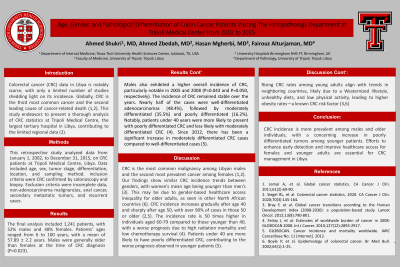Tuesday Poster Session
Category: Colon
P3633 - Age, Gender, and Pathological Differentiation of Colon Cancer Patients Visiting The Histopathology Department at Tripoli Medical Center From 2002 to 2015
Tuesday, October 29, 2024
10:30 AM - 4:00 PM ET
Location: Exhibit Hall E

Has Audio

Ahmed Shukri, MD
Texas Tech University Health Sciences Center
Lubbock, TX
Presenting Author(s)
Ahmed Shukri, MD1, Ahmed Zbedah, MD2, Hasan Mgherbi, MD2, Fairouz Alturjaman, MD2
1Texas Tech University Health Sciences Center, Lubbock, TX; 2University of Tripoli, Lubbock, TX
Introduction: Colorectal cancer (CRC) data in Libya is notably scarce, with only a limited number of studies shedding light on aspects of its incidence. This study endeavors to present a thorough analysis of CRC statistics at Tripoli Medical Centre, the largest tertiary hospital in Libya.
Methods: This retrospective study analyzed data from January 1, 2002, to December 31, 2015, on CRC patients at Tripoli Medical Centre, Libya. Data included age, sex, tumor stage, differentiation, location, and sampling method. Inclusion criteria were CRC confirmed by colonoscopy and biopsy. Exclusion criteria were incomplete data, non-adenocarcinoma malignancies, anal cancer, secondary metastatic tumors, and recurrent cases.
Results: The final analysis included 1,241 patients, with 52% males and 48% females. Patients’ ages ranged from 6 to 100 years, with a mean of 57.89 ± 2.2 years. Males were generally older than females at the time of CRC diagnosis (P=0.023). Males also exhibited a higher overall incidence of CRC, particularly notable in 2005 and 2008 (P=0.043 and P=0.050, respectively). The incidence of CRC remained stable over the years. Nearly half of the cases were well-differentiated adenocarcinomas (48.4%), followed by moderately differentiated (35.5%) and poorly differentiated (16.2%). Notably, patients under 40 years were more likely to present with poorly differentiated CRC and less likely with moderately differentiated CRC. Since 2012, there has been a significant increase in moderately differentiated CRC cases compared to well-differentiated cases.
Discussion: CRC is the most common malignancy among Libyan males and the second most prevalent cancer among females. Our findings show similar CRC incidence trends between genders, with women’s mean age being younger than men’s. This may be due to gender-based healthcare access inequality for older adults, as seen in other North African countries. CRC incidence increases gradually after age 40 and sharply after age 50, with over 90% of cases in those 50 or older. The incidence rate is 50 times higher in individuals aged 60-79 compared to those younger than 40, with a worse prognosis due to high radiation mortality and low chemotherapy survival. Patients under 40 are more likely to have poorly differentiated CRC. Rising CRC rates among young adults align with trends in neighboring countries, likely due to a Westernized lifestyle, unhealthy diets, and low physical activity, leading to higher obesity rates—a known CRC risk factor.
Disclosures:
Ahmed Shukri, MD1, Ahmed Zbedah, MD2, Hasan Mgherbi, MD2, Fairouz Alturjaman, MD2. P3633 - Age, Gender, and Pathological Differentiation of Colon Cancer Patients Visiting The Histopathology Department at Tripoli Medical Center From 2002 to 2015, ACG 2024 Annual Scientific Meeting Abstracts. Philadelphia, PA: American College of Gastroenterology.
1Texas Tech University Health Sciences Center, Lubbock, TX; 2University of Tripoli, Lubbock, TX
Introduction: Colorectal cancer (CRC) data in Libya is notably scarce, with only a limited number of studies shedding light on aspects of its incidence. This study endeavors to present a thorough analysis of CRC statistics at Tripoli Medical Centre, the largest tertiary hospital in Libya.
Methods: This retrospective study analyzed data from January 1, 2002, to December 31, 2015, on CRC patients at Tripoli Medical Centre, Libya. Data included age, sex, tumor stage, differentiation, location, and sampling method. Inclusion criteria were CRC confirmed by colonoscopy and biopsy. Exclusion criteria were incomplete data, non-adenocarcinoma malignancies, anal cancer, secondary metastatic tumors, and recurrent cases.
Results: The final analysis included 1,241 patients, with 52% males and 48% females. Patients’ ages ranged from 6 to 100 years, with a mean of 57.89 ± 2.2 years. Males were generally older than females at the time of CRC diagnosis (P=0.023). Males also exhibited a higher overall incidence of CRC, particularly notable in 2005 and 2008 (P=0.043 and P=0.050, respectively). The incidence of CRC remained stable over the years. Nearly half of the cases were well-differentiated adenocarcinomas (48.4%), followed by moderately differentiated (35.5%) and poorly differentiated (16.2%). Notably, patients under 40 years were more likely to present with poorly differentiated CRC and less likely with moderately differentiated CRC. Since 2012, there has been a significant increase in moderately differentiated CRC cases compared to well-differentiated cases.
Discussion: CRC is the most common malignancy among Libyan males and the second most prevalent cancer among females. Our findings show similar CRC incidence trends between genders, with women’s mean age being younger than men’s. This may be due to gender-based healthcare access inequality for older adults, as seen in other North African countries. CRC incidence increases gradually after age 40 and sharply after age 50, with over 90% of cases in those 50 or older. The incidence rate is 50 times higher in individuals aged 60-79 compared to those younger than 40, with a worse prognosis due to high radiation mortality and low chemotherapy survival. Patients under 40 are more likely to have poorly differentiated CRC. Rising CRC rates among young adults align with trends in neighboring countries, likely due to a Westernized lifestyle, unhealthy diets, and low physical activity, leading to higher obesity rates—a known CRC risk factor.
Disclosures:
Ahmed Shukri indicated no relevant financial relationships.
Ahmed Zbedah indicated no relevant financial relationships.
Hasan Mgherbi indicated no relevant financial relationships.
Fairouz Alturjaman indicated no relevant financial relationships.
Ahmed Shukri, MD1, Ahmed Zbedah, MD2, Hasan Mgherbi, MD2, Fairouz Alturjaman, MD2. P3633 - Age, Gender, and Pathological Differentiation of Colon Cancer Patients Visiting The Histopathology Department at Tripoli Medical Center From 2002 to 2015, ACG 2024 Annual Scientific Meeting Abstracts. Philadelphia, PA: American College of Gastroenterology.
